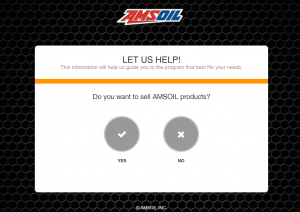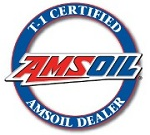As a long time Motorcyclist with over 100,000 miles of riding experience on a vareity of bikes I found the article below to be informative to anyone who rides especially those with air cooled V-twins. I’ve ridden all over the country from the desert southwest where daytime temps could reach 115 degree to humid and hot southeast like Alabama and Virginia. Many times riding in the summer, especially in town can be extremely hot for the rider and the bike motor. Understanding how lubricants can play a major role in protecting engines, transmissions and primaries is key to your long term investment.

This article written by Len Groom, AMSOIL Technical Product Manager for Powersports is an avid V-twin rider and experienced motorcyclist as well as our top corporate employee when it comes to motorcycles and powersports. The article was published in the August 2018 AMSOIL Dealer magazine.
Don’t let extreme heat sideline your bike
Motorcycles are meant to be ridden, not pushed.
As you near the town of Sturgis, S.D., the epicenter of biker culture for more than a week traffic slows to a crawl. A mile or two later, you start seeing riders pulled over on the shoulder. Some stand idly by their bikes, some push them down the road as the blazing sun beats down upon them.
Here’s what often happens. As heat intensifies, motor oil loses viscosity and becomes thinner. The oil can become so thin that the engine loses oil pressure, causing the oil-pressure gauge to bottom out. The rider may notice increased valvetrain and gear noise as parts clatter together. Any rider worth his or her salt knows that you don’t run your engine with no oil pressure, so he or she shuts it down and sits alongside the highway (or pushes the bike) until the engine cools enough to restore oil pressure.
Air-cooled V-twins get plenty hot on their own, but riding in slow-moving traffic makes it worse. Crawling along barely above idle doesn’t generate Sufficient airflow to cool the engine. Add to that the blazing sun reflecting off the asphalt, and it’s a recipe for trouble. In extreme dyno testing designed to create heat, we’ve seen cylinder temperatures in a 2012 Harley-Davidson* Street Bob* as high as 383ºF (195ºC).
It’s up to the motor oil to protect the engine despite the intense heat. However, oil becomes thinner as it heats up, and if it becomes too thin, it can fail to form a libriant film of sufficient thickness and strenght to prevent metal components from contacting during engine operation and wearing out. Once the
lubricant film fails, it falls on the anti-wear additives to prevent wear. They form a sacrificial layer on components to keep them from contacting. But additives are designed to deplete with time and use. Once they wear out, your engine isn’t protected in this scenario.
Although heat is a bigger challenge for air-cooled engines, extreme heat can also negatively affect liquid-cooled bikes, even though they run much cooler. How much cooler? Testing of a liquid-cooled Indian* Scout* in our mechanical lab revealed cylinder temperatures averaged 200ºF (93ºC), far cooler than the Harley running the same test. That’s because a liquid-cooled motor relies on a jacket of coolant/water surrounding the cylinders to absorb heat and carry it to the radiator, where it dissipates into the atmosphere. Water/coolant is a more effective heat-transfer medium than air, which you can clearly see in the cylinder-temperature difference between the two bikes.
Even so, engine and oil temperature will still increase along with ambient heat, so it’s just as important to use a good motorcycle oil in liquid-cooled engines.
The rate at which oil oxidizes, or chemically breaks down, doubles for every 18ºF (10ºC) increase in lubricant temperature. Oxidation occurs when oxygen molecules attack oil molecules and result in a chemical reaction that leads to harmful byproducts, like sludge and varnish. The faster the oil oxidizes, the sooner it wears out and requires changing.
Liquid-cooled engines may run cooler and help prevent overheating, but in case you hadn’t noticed, riders are fiercely loay to their bikes. Their big air-cooled V-twin is an extension of their personality, and they aren’t about to trade it in for another brand just because it’s hot outside.
This situation perfectly illustrates the importance of selling AMSOIL products as solutions to your customers’ problems. AMSOIL Synthetic V-Twin Motorcycle Oil uses high-quality synthetic base oils that naturally resist thinning due to extreme heat and mechanical activity better than conventional base oils. As a result, it forms a thick strong lubricating film on engine components despite the intense heat. Although any oil will become thinner in extreme heat, riders who use AMSOIL Synthetic V-Twin Motorcycle Oil won’t see their oil-pressure gauges bottom out. Providing the confidence they need to keep riding after others have shut down their bikes and started pushing. With AMSOIL, your customers don’t have to buy a different bike, they just have to buy a better motorcycle oil.

PS, don’t forget AMSOIL Motorcycle Oil Filters as well as Motorcycle Octane Boost if you are riding in high temperatures to prevent pre-detonation (pinging)
Purchasing AMSOIL synthetic motorcycle oil is easy with the AMSOIL Online Store. Just add the products you want, choose your shipping address and you will receive the products on your doorstep in 2-3 days. We recommend anyone purchasing over $100 to try out the AMSOIL Preferred Customer Program to save 20-25% off of retail. Learn more about the Preferred Customer Program.





